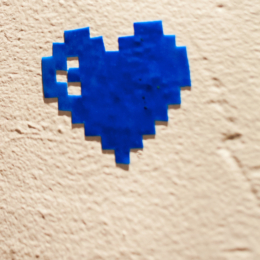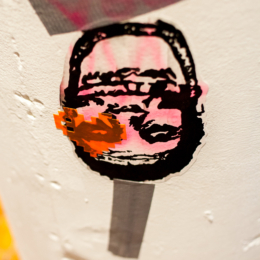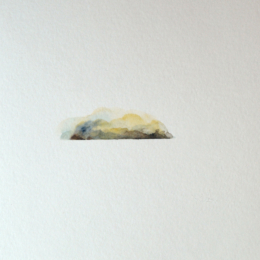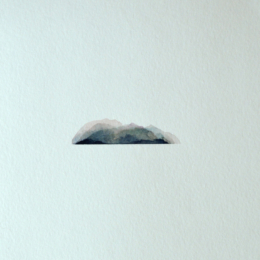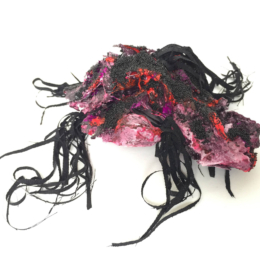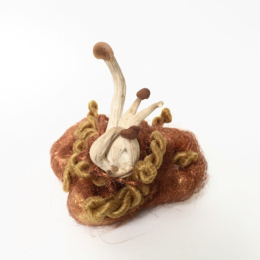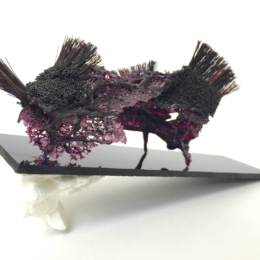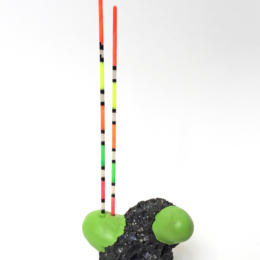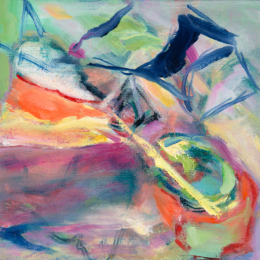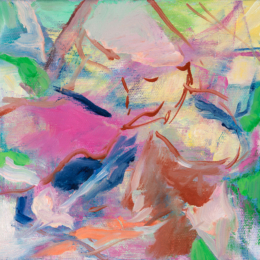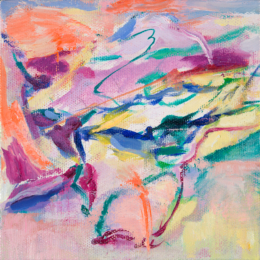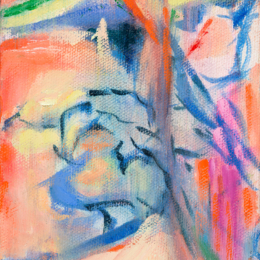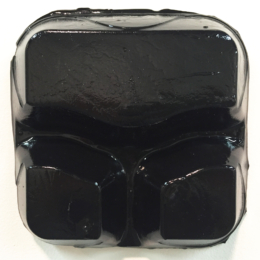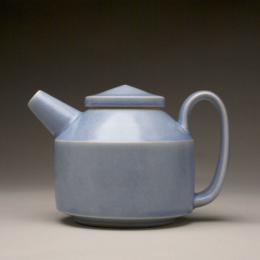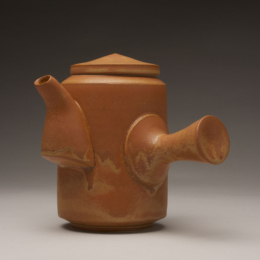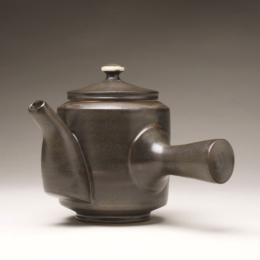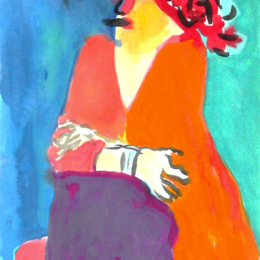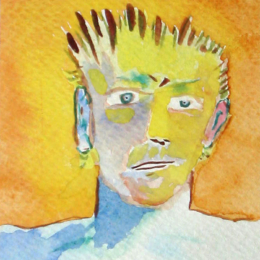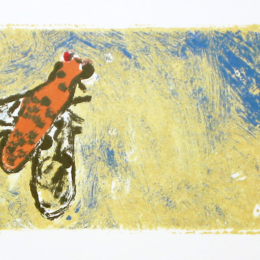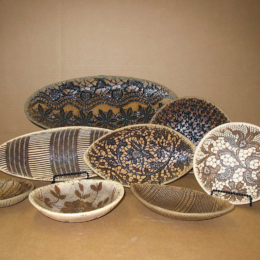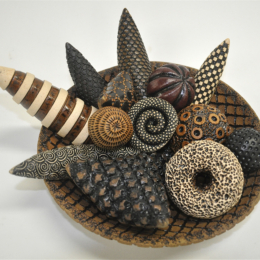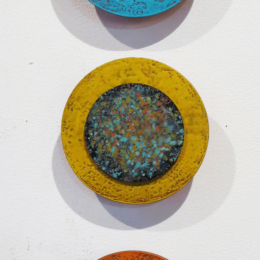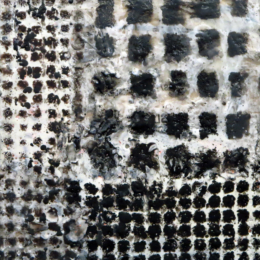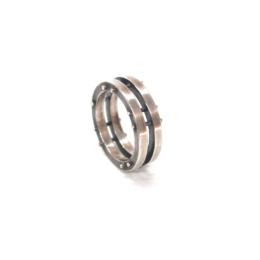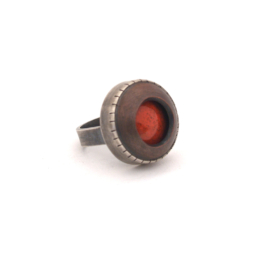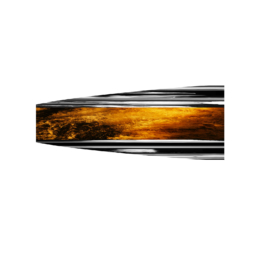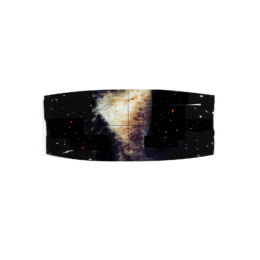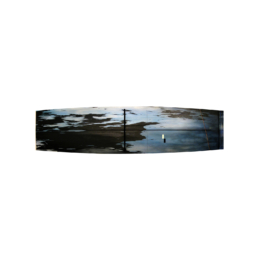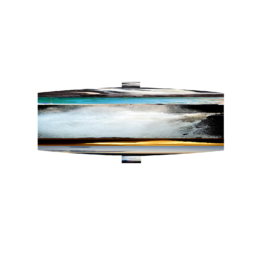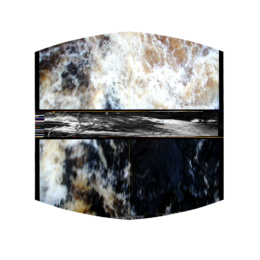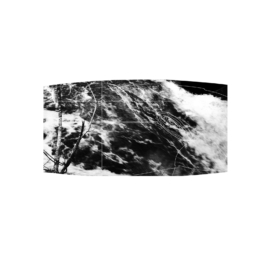About the Artist
Rachel Andrzejewski: Rachel likes to fluctuate between large-scale installations and smaller works that demand the viewer’s intimacy. She has been working with layered transparent photography, and also recently with creating tiny planters for exotic air plants. When working on this smaller scale, she is enchanted by the idea of tiny exploration and inspection. “That you as the viewer would have to try all angles, avoid and embrace reflections, investigate minuscule plant growth. There is something profound and private about finding the little things for yourself.”
Erik Benson: Erik decided not to make a small painting for Tiny Art. Rather, he chose to focus on some of the individual components that are found in his paintings. This decision allowed him to see how focusing on a single element might influence the content and the meaning of the work. Thus, Erik’s tiny artworks are four hand painted “stickers.”
Betsy Ruth Byers: Betsy’s studio practice is anchored by an interest in the relationship between perception and the surrounding environment. Prioritizing the interaction of color, surface and mark as integral to the outcome of her work, the progression of each painting draws on sensual traces and fleeting memories for direction of imagery and color. Often, her canvases span over six feet, therefore, shifting to a smaller scale for this show demanded a re-calibration of how Betsy created space. The intimacy of working with watercolor on a small scale requires attention to each stroke of the brush. Accordingly, her pace of mark making slowed down significantly, and she truly enjoyed the intimacy of creating tiny worlds that she hopes evoke an experience of immensity for the viewer.
Kate Casanova: For this exhibition, Kate set out to create a series of sculptures that explore organic and man-made materials such as rock, foam, fabric, wood, dried mushrooms and found objects. The challenge she faced while working at a small scale was to create forms that, “from a distance, have the power to pull in a viewer and then hold their attention with small details when they draw close.” The sculptures Kate created pose questions about what is “natural.” They function as tiny artifacts of some unknown narrative or objects of curiosity from a mysterious natural history.
Jil Evans: Gallery artist Jil Evans, whose large-scale abstractions are highly intelligent compositions of sensation, line and form, created small works based on photographic images she took of what lies beneath a swamp in Minneapolis’ Theodore Wirth Park. The challenge she set for herself was to make the largest worlds she could in the small space in which she was working. “I think there is something naturally satisfying to us, exciting for us, to look into a small space and find a world larger than the room we are standing in. It’s always about making more space!”
Nathanael Flink: Nathanael’s artwork deals with observing society through the filter of his daily experiences, and how traditions, roles and routines of families in America function. Through observing and connecting to his own place in the world, he investigates things that are taken for granted, but reveal poignancy. Through his Tiny Art piece, “Lunch Tray,” Nathanael examines the materiality of product packaging.
Ernest Miller: When making pottery for everyday use, Ernest typically works within scale parameters having the function and user in mind. So for example, if the object is a cup, it needs to be easy to lift and fit comfortably into the hand. This is true for all of Ernest’s objects be it a teapot, dinner plate, soup bowl and so on. Pots, because they are small, tend to be investigated through touch and being held creating an intimacy with the object. For this show, Ernest chose to make a selection of teapots with service for one or two tea enthusiasts.
Jon Neuse: Jon enjoys making small works for three reasons. 1. They are intimate: a viewer’s close inspection reveals both perfection and shortcoming. 2. They are compositionally demanding: to be successful, every mark must be in its exact place. 3. They are economical: they are quick to make and they can be created on scrap paper.
Kelly Jean Ohl: Kelly’s intricately crafted ceramics are small, delicate and abstract. Her art objects reference biological entities throughout the natural world—whether clinging to rocks in a tidal pool, swimming beneath the viewfinder of a microscope, or intertwined on a forest floor—with compelling non-specificity. Each of her hand-made objects, whether of porcelain or stoneware, may also include handmade textiles. She carves the works’ intricate designs using a variety of household utensils and dental tools. A lengthy process of sanding, firings and hand-painting yields highly textural work encrusted with layers of markings and meanings. “When a collector picks up one of my pieces they see the detailed carving, feel the unique tactile quality of the surface and then also realize the piece makes sounds. This is my way of acknowledging that the work was meant to be touched. It’s part of the experience.”
Jodi Reeb: In this new series of small paintings, Jodi uses contrasting materials and substrates to create works that oscillate between painting and sculpture. She uses solid substrates made of wood and circular acrylic panels using encaustic (beeswax) and acrylic paint as well as metallic paints that transform or react when combined. Jodi begins with a layer of paint or a structure, and from that point on, it becomes about process; making marks and textures, applying materials, responding to each action with a reaction. Combinations are discovered, explored, proposed, rejected and accepted as part of the art-making process. Because they are small, the paintings can be moved around in varying compositions. As each work evolves, it gains an identity that eventually solves itself through process, positive and negative space and dimension.
Danny Saathoff: For Danny, working on a small scale is quite natural. The sculptures that he creates are influenced directly from his work as a jewelry designer. Danny’s jewelry is small-scale sculptures and his sculptures are large-scale jewelry. The difference happens when the work moves from the body to the gallery. For jewelry, the gallery is the human body.
Cameron Zebrun: Cameron’s main focus for producing the body of work for Tiny Art was to create a series based on his photography. This series is united by textures, shapes, color and of course the small size. Usually his work is larger – on a human scale – so these images presented two unique challenges for him: they are tiny and they are two-dimensional. His usual process of making sculpture is an additive one. He begins by creating a form, and then adding color and sometimes other elements to the form. With this series the process was more about taking away, hiding, changing and composing elements. Cameron learned that in the end he was working toward the same goal as when he creates his sculptural pieces. Both mediums use composition and craftsmanship to communicate emotion and his relationship with the natural world through a studio process of discovery and revelation.

